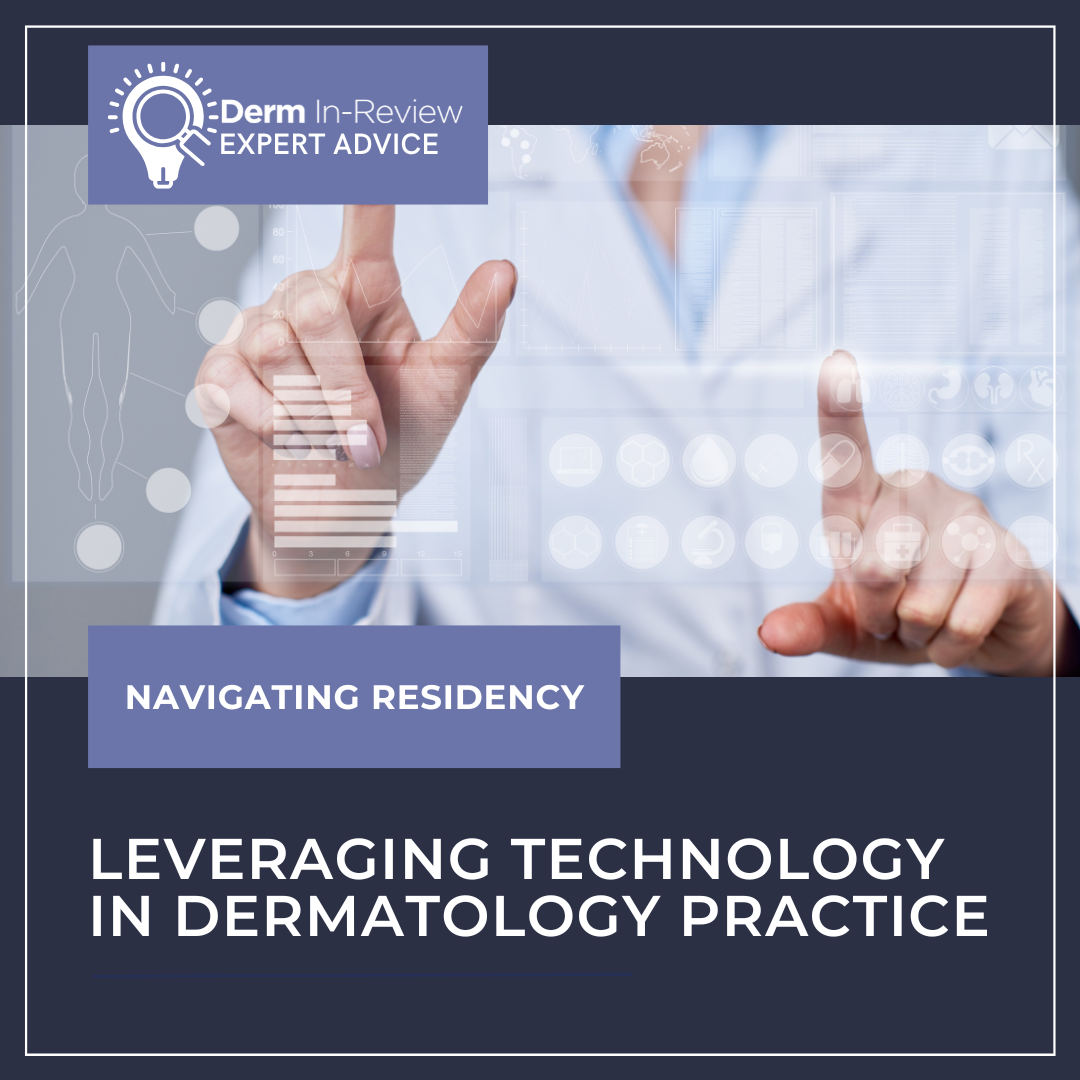Technology is continuously reshaping the practice of dermatology, affecting documentation workflows, and patient engagement and outreach. For dermatology residents, developing a strategic approach to digital tools during training can translate into a growing practice that provides efficient and high-quality patient care.
Optimizing the Electronic Medical Record
Documentation remains one of the most time-consuming responsibilities in dermatologic practice, but advances in electronic medical records (EMRs) are helping to rebalance that workload. Modern dermatology EMRs now support image-heavy workflows, allowing for direct upload of clinical and dermoscopic photographs, longitudinal lesion tracking, and structured data capture for biopsy logs and skin cancer staging. These features improve continuity of care, enable quality reporting, and reduce the need for redundant documentation. Interoperability also allows integration with third-party tools such as lesion registries, decision-support modules, and teledermatology platforms.
Artificial intelligence and automation are increasingly embedded within these systems. Emerging features include automated visit summaries, intelligent CPT and ICD coding suggestions, and adaptive templates that learn provider preferences. Voice dictation and AI-based “ambient” scribe technologies, as well as virtual scribes, can further reduce documentation time and increase direct patient interaction. In parallel, digital intake and online check-in platforms streamline front-office operations by collecting demographic information, medication lists, and chief complaints before the visit—enhancing efficiency and data accuracy.
For dermatology residents, these tools present an opportunity to establish efficient habits early in training. Customizing encounter templates and activating imaging integrations can significantly reduce administrative workload. Increased exposure to different platforms allows residents to see which ones would work best for them in further practice. If these tools aren’t available in one’s academic setting, residents should shadow at practices that are on the cutting edge of automation. Reach out to attendings that also work off-site, as well as former residents, for these opportunities. Residents can also attend technology-forward conferences (such as the AAD Innovation Academy) for sessions on advancements in business management.
Using Artificial Intelligence (AI) Tools for Patient Education
AI can speed production of clear and accessible patient handouts, but the output quality depends heavily on the prompt.
- Essential prompt elements include:
- Target audience & reading level: “Write for a dermatology patient audience at a 6th–8th grade (middle-school) reading level.”
- Scope & length: “Limit to 250–400 words for a handout; longer (up to 800–1,000 words) if including clinical trial evidence and references.”
- Clinical accuracy & citations: “Cite peer-reviewed randomized controlled trials supporting the primary recommendation; list full citations in AMA format.”
- Actionable aftercare & red flags: “Include 5 clear ‘When to call your clinic or seek urgent care’ items.”
- Clinic-specific details: “Insert my clinic phone number, after-hours instructions, and follow-up timing.”
- Accessibility & language: “Provide a Spanish translation version, as well as a version for low-vision patients (large font and bullet points).”
- Formatting instructions: “Use bullets, headings, and bold ‘Key takeaways’; include suggested QR code text for linking to a 2-minute wound-care video.”
- Tone & cultural sensitivity: “Write in a neutral, empathetic tone and avoid stigmatizing language.”
Clinicians must verify clinical accuracy and cite primary evidence for in-depth documents. Always confirm institutional policies on external AI tools and patient-facing materials before making them available to patients.
Digital Organization and AI for Residents
Residency demands constant multitasking—balancing clinical duties, didactics, research, and board preparation. Digital organization platforms can help manage these competing priorities efficiently.
Task management applications such as Todoist, Asana, or Microsoft To Do support prioritization of clinical responsibilities and academic projects. Reference management software like Zotero or Mendeley simplifies citation organization for journal clubs and manuscript preparation.
Note-consolidation platforms, such as Notion, OneNote, and Evernote, allow residents to compile lecture notes, clinical pearls, and protocols into a single searchable database accessible across devices.
AI-enabled productivity tools add another layer of efficiency. These include applications that summarize journal articles, extract key study data, generate flashcards for board review, or propose customized study schedules. The key is intentional adoption—choosing tools that genuinely streamline workflow rather than add digital clutter.
Professional Use of Social Media
Social media offers opportunities for education, professional networking, and patient outreach. Dermatologists are increasingly using platforms such as Instagram, YouTube, and TikTok to share evidence-based information, counter misinformation, and engage the public in skin health awareness.
Before creating professional accounts, residents should review their institutional policies and employment contracts. Many hospitals have specific guidelines on posting clinical content or using patient images, even when de-identified. Maintaining a clear boundary between professional and personal identities is essential, and all content should adhere to HIPAA and ethical standards.
Conclusion
Dermatology continues to be at the forefront of medical technology implementation. By investigating options for EMR optimization, practicing how to leverage AI for patient education, and adopting organizational technologies effectively, dermatology residents can enhance both their learning and patient care.
Residency provides the ideal environment to experiment with these innovations safely and thoughtfully. Building digital fluency during training establishes the foundation for an efficient, adaptive, and patient-centered practice in the years ahead.
Did you enjoy this article? You can find more on Navigating Residency here.

